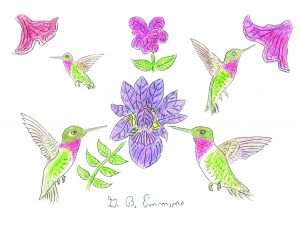For many backyard bird watchers, this cherished furtive, rapid-flying figure flitting from flower to feeder and then hovering in midflight is the only one of some twenty other hummingbird species that is common east of the Mississippi, prevalent in Canada and the United States.
The male ruby-throated hummingbirds arrive here in mid April ahead of the females about the time when floral berries and insects begin to flourish to welcome their arrival. When the female joins him a short time later, a mating dance of aerial acrobatics ensues over the bucolic blossoming floral dance floor as both sexes transform into a kaleidoscope of changing hues in a shimmering display created as light refracts from their multi-faceted throat and body plumage.
If love was in the air, an ensuing tiny cobweb or lichen nest will result nearby – hard to spot, even though they often raise more than one brood per season. But when you venture out on your kitchen deck, you will know it is there when the male flies at you in a loud dive-bombing flurry.
With wing beats so rapid as in a good card trick that can defy the eye, they use seven times the oxygen when flying than when at rest. They are particularly attracted to the color red in flowers or feeders, but deep purple clusters of irises, as in my drawing, is also identified to be a castle of seductive nectar sustenance. There are many others such as bee balm, tulips, or viburnum, where they hover to sip nectar using a tongue barbed for that purpose.
When too many family members compete for the same relished food source, one can clearly hear the commotion when they dive bomb each other and joust with a threatening demeanor. They also emit a series of short squeaky notes to express their excitement of competitive combat for sustenance.
But all too soon, the summer will wind down their excitement as a variable food supply changes every day, and the long journey to Florida or Central America is just over the horizon.
Very little is known about their coming and going, but it seems to be a daily amount of travel noticed just above tree level if by land and slightly above waves if by water. But they seem to be always ahead of the isotherm (average nightly temperature) since this is just above freezing, pushing the limit as far as being able to find insects and flowering plants that don’t thrive during freezing nights.
The last passing-through migrants may appear here just before mid-October, as in the sentimental end-of-summer September song of the 1950s, “The Days Grow Short When You Reach September, And I Don’t Have Time For The Waiting Game.” One day, without saying good-bye, suddenly they are gone, leaving a solemn void in our backyard bird watching entertainment. But I have been fortunate to share it with you ahead of time.
By George B. Emmons
